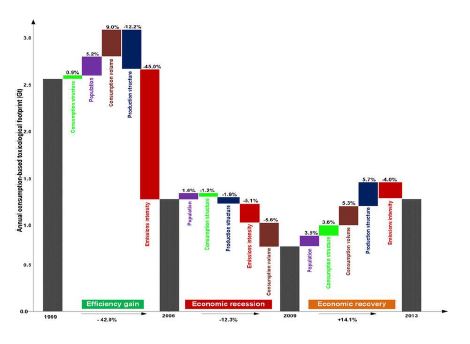2016年12月22日
水産・環境科学総合研究科の藤井秀道准教授ら研究グループによる論文「Drivers of U.S. toxicological footprints trajectory 1998-2013」」が、12月21日付のScientific Reports誌に掲載
|
本研究では、米国域内における最終消費の動向が、米国産業部門から排出される毒性化学物質の誘発量にどのように影響しているかを解析したものです。解析では、毒性化学物質排出量の増減を、消費構造、人口規模、人口当たりの消費量、生産構造、生産工程内の環境技術の5つの要因に分解することで、どの要因が誘発量変化に大きな影響を与えているかを明らかにしています。本研究成果は、毒性化学物質管理を効果的に進めていく上で必要不可欠となる「主要な誘発源の見える化」に貢献するとともに、環境政策を立案する際の重要な科学的根拠として活用されることが期待されます。
Drivers of U.S. toxicological footprints trajectory 1998–2013 論文ページURL: http://www.nature.com/articles/srep39514 Abstract By exploiting data from the Toxic Release Inventory of the United States, we have established that the toxicological footprint (TF) increased by 3.3% (88.4 Mt) between 1998 and 1999 and decreased by 39% (1088.5 Mt) between 1999 and 2013. From 1999 to 2006, the decreasing TF was driven by improvements in emissions intensity (i.e. gains in production efficiency) through toxic chemical management options: cleaner production; end of pipe treatment; transfer for further waste management; and production scale. In particular, the mining sector reduced its TF through outsourcing processes. Between 2006 and 2009, decreasing TF was due to decrease in consumption volume triggered by economic recession. Since 2009, the economic recovery increased TF, overwhelming the influence of improved emissions intensity through population growth, consumption and production structures. Accordingly, attaining a less-toxic economy and environment will be influenced by a combination of gains in production efficiency through improvement in emissions mitigation technologies and changes in consumption patterns. Overall, the current analysis highlights the structural dynamics of toxic chemical release and would inform future formulation of effective mitigation standards and management protocols towards the detoxification of the environment. |






 受験生
受験生 在学生
在学生 卒業生
卒業生 保護者等
保護者等 地域・一般
地域・一般 企業・研究者
企業・研究者 教職員
教職員
